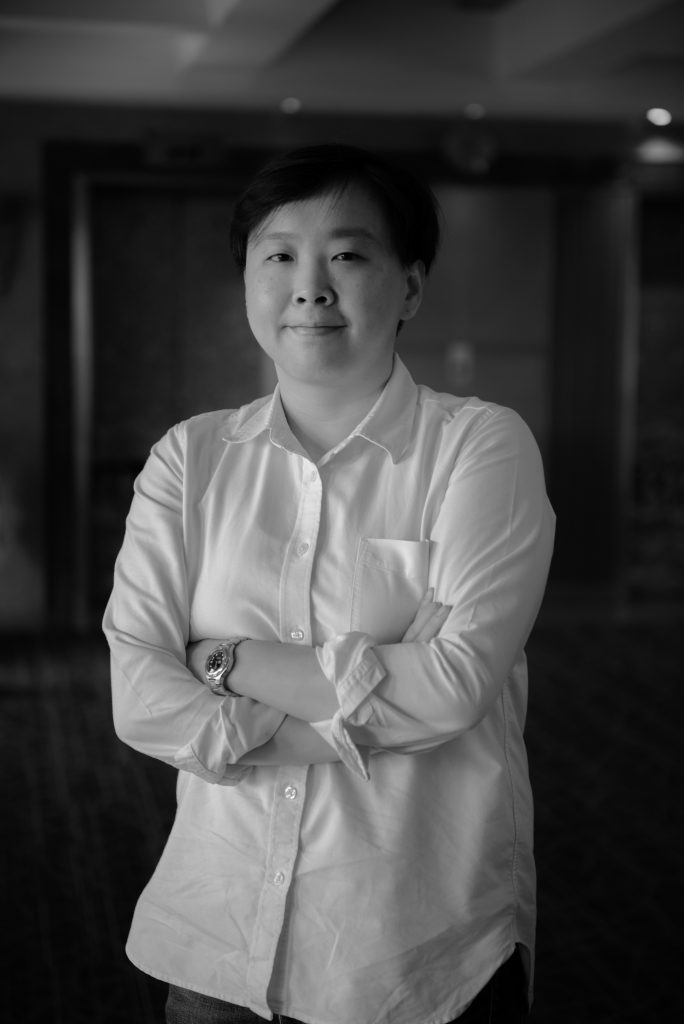Pheereeya Boonchaiyapruek and Piya Limpiti of Urban Ally introduce the conceptual framework for this year’s architectural exhibition layout, hosting over 500 exhibitors and crafting a microcosm of a city teeming with a medley of displays, activities, and products.
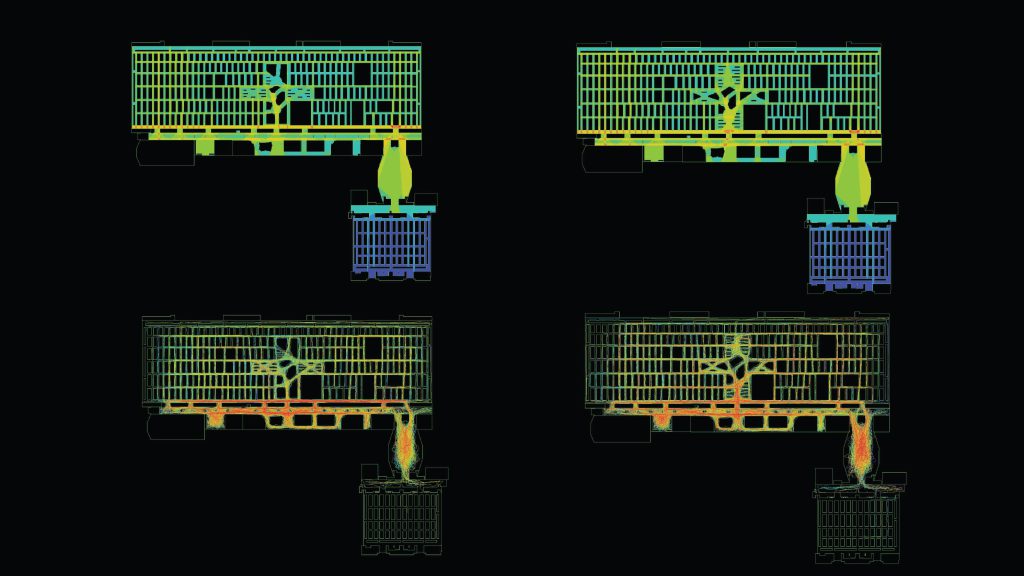
Collective (City) Language กับการออกแบบผังเมืองขนาดย่อมในงานสถาปนิก’67 ผ่าน Pattern Language
“เรารู้สึกว่าในพื้นที่ของงานสถาปนิกก็เหมือนกับเป็นเมืองย่อม ๆ เรารู้สึกว่าผังพื้นที่ของงาน โดยเฉพาะส่วนจัดแสดงหลักตรงกลางควรเป็นพื้นที่ที่โฟลว์เข้าถึงได้ง่าย ไม่รู้สึกว่าเป็นพื้นที่เฉพาะของใครคนใดคนหนึ่ง แล้วจะต้องรู้สึกสบายที่ได้เดินไปมาบนพื้นที่แห่งนี้ เรารู้สึกว่านี่คือประเด็น”
ดร.พีรียา บุญชัยพฤกษ์ รองผู้อำนวยการศูนย์มิตรเมือง (Urban Ally) คณะสถาปัตยกรรมศาสตร์ มหาวิทยาลัยศิลปากร เริ่มต้นเล่าถึงแนวคิด ของการจัดผังงานสถาปนิกในปีนี้ ซึ่งรวบรวมผู้จัดแสดงงานกว่า 500 รายที่เปรียบเสมือนเมืองจำลองขนาดย่อมที่มีทั้งการจัดแสดงชิ้นงาน กิจกรรมและการจัดแสดงสินค้าที่หลากหลาย
“มันก็เหมือนกับเป็นพื้นที่ที่ความหลากหลายมาอยู่ร่วมกันในความเป็นเมืองขนาดย่อม เราจึงต้องพยายามหาภาษากลางที่จะสามารถสื่อสารให้คนเข้าใจ เหมือนเป็นภาษาสถาปัตยกรรม ภาษาของเมือง” จากจุดนี้จึงเชื่อมโยงสอดคล้องไปกับธีมของงาน Collective Language ที่ ปิยา ลิ้มปิติ รองผู้อำนวยการศูนย์มิตรเมือง คณะสถาปัตยกรรมศาสตร์ มหาวิทยาลัยศิลปากร เล่าให้เห็นถึงการใช้ภาษาของเมืองมาอธิบายและประยุกต์เข้ากับการจัดพื้นที่ผังนิทรรศการ
ความรู้สึกของการเดิน ชมงานสถาปนิก’67 โดยเฉพาะกับส่วนจัดแสดงหลักของงานรับรู้ได้ถึงความแตกต่างไปจากปีก่อนหน้า ทั้งรูปแบบเส้นทางเดินที่เกิด ขึ้นได้อย่างอิสระ มองเห็นกิจกรรมหรือการจัดแสดงในบูธที่รายรอบ รวมทั้งทัศนวิสัยที่มีต่อแต่ละพาวิเลียน นี่เองที่ภาษาของงานออกแบบผังเมืองได้เข้ามามีบทบาทในพื้นที่แห่งนี้
ดร.พีรียา บุญชัยพฤกษ์ รองผู้อำนวยการศูนย์มิตรเมือง (Urban Ally) ปิยา ลิ้มปิติ รองผู้อำนวยการศูนย์มิตรเมือง (Urban Ally)
จาก Pattern Language สู่ Activity Node
“เราพยายามหาคอนเซปต์ที่พูดถึงสเกลของเมืองที่ใช้งานร่วมกันได้ในการพัฒนาผังพื้นของงาน เราเลยคิดถึงหนังสือ A Pattern Language ของ Christopher Alexander สถาปนิกผังเมืองและนักคิดเรื่องเมือง”
หนังสือเล่มนี้รวบรวมคุณลักษณะของพื้นที่ในเมืองที่เกิด จากการร้อยเรียงของอาคาร เส้นทางสัญจร พื้นที่ว่างและกิจกรรมในเมืองเข้าด้วยกันเป็นองค์ประกอบของสิ่งที่เรียกว่าเมือง จากแนวความคิดเหล่านี้นำมาพัฒนาและวิเคราะห์เป็นผังพื้นนิทรรศการ ร่วมไปกับการวางผังด้วยเทคนิค Space Syntax ซึ่งเป็นเครื่องมือวิเคราะห์ความสัมพันธ์ของพื้นที่เมืองต่าง ๆ ทางสัญจรหรือการเคลื่อนผ่านระหว่างแต่ละพื้นที่ แล้วพัฒนาต่อเป็นไกด์ไลน์สำหรับดีไซเนอร์ในการออกแบบผังพื้นต่อไป ภาษาจากหนังสือ A Pattern Language ที่ศูนย์มิตรเมืองเลือกใช้คือ การสร้างจุดศูนย์รวมกิจกรรม หรือ Activity Node ควรมีคุณลักษณะ 4 อย่าง ได้แก่ เส้นทางเดิน หลักจากพื้นที่โดยรอบที่ตัดกันที่จัตุรัส สร้างเป็นแพตเทิร์นรูปดาว จัตุรัสสาธารณะขนาดเล็ก สิ่งอำนวยความสะดวกในพื้นที่ที่ดึงดูดผู้คนให้เข้ามาใช้งาน และจุดศูนย์รวมกิจกรรมที่กระจายตัวอยู่
“พื้นที่จัตุรัสที่เป็นพื้นที่สาธารณะหรือพื้นที่ส่วนกลางสำหรับทำกิจกรรม ควรลากทางเดินทุกเส้นตัดผ่านพื้นที่ว่างตรงนี้ แล้วสร้างออกมาให้เป็นจุดตัดรวมกันให้เหมือนเป็นรูปดาว ซึ่งพื้นที่จัตุรัสไม่จำเป็นต้องใหญ่ และสามารถกระจายตัวได้ โดยมีพื้นที่กิจกรรมอยู่ล้อมรอบ ซึ่งกิจกรรมเหล่านี้ควรสอดประสานกันไปทั้งหมด เพื่อดึงดูดคนที่ต้องการหรือสนใจสิ่งคล้าย ๆ กันเข้ามาอยู่ในพื้นที่เดียวกัน แล้วจุดกิจกรรมเหล่านี้ควรกระจายตัวไปทั่วบริเวณ”
พีรียาชี้ให้เห็นว่า การใช้งานออกแบบผังเมืองเข้ามาออกแบบนิทรรศการช่วยให้เห็นถึงวิธี การใช้งานพื้นที่โดยรวมอย่างคุ้มค่า ให้เห็นถึงพื้นที่สาธารณะส่วนกลางที่เป็นของทุกคนเป็นสำคัญ การจัดสรรพื้นที่สอดคล้องไปกับรูปแบบความต้องการใช้งาน รวมทั้งยังเปลี่ยนจากเดิมที่อาจเคยมีพื้นที่เศษเหลือมุมอับให้กลายมาเป็น Positive Space หรือพื้นที่ที่ถูกใช้งานได้ทั้งหมด “สุดท้ายคือการซึมผ่านหรือไหลผ่านพื้นที่เป็นปัจจัยสำคัญ และทัศนวิสัยเป็นตัวแปรแห่งความสำเร็จ เพราะถ้าเรามองเห็นได้ เราก็อยากจะเดินไปถึงส่วนที่มองเห็น เพราะฉะนั้นการวางพาวิเลียน หรือแม้กระทั่งการทำให้เกิดจุดเด่นต่าง ๆ เป็นส่วนสำคัญมากที่ทำให้คนเดินไหลลื่นเข้ามายังพื้นที่ต่าง ๆ ภายในฮอลล์ของงาน”
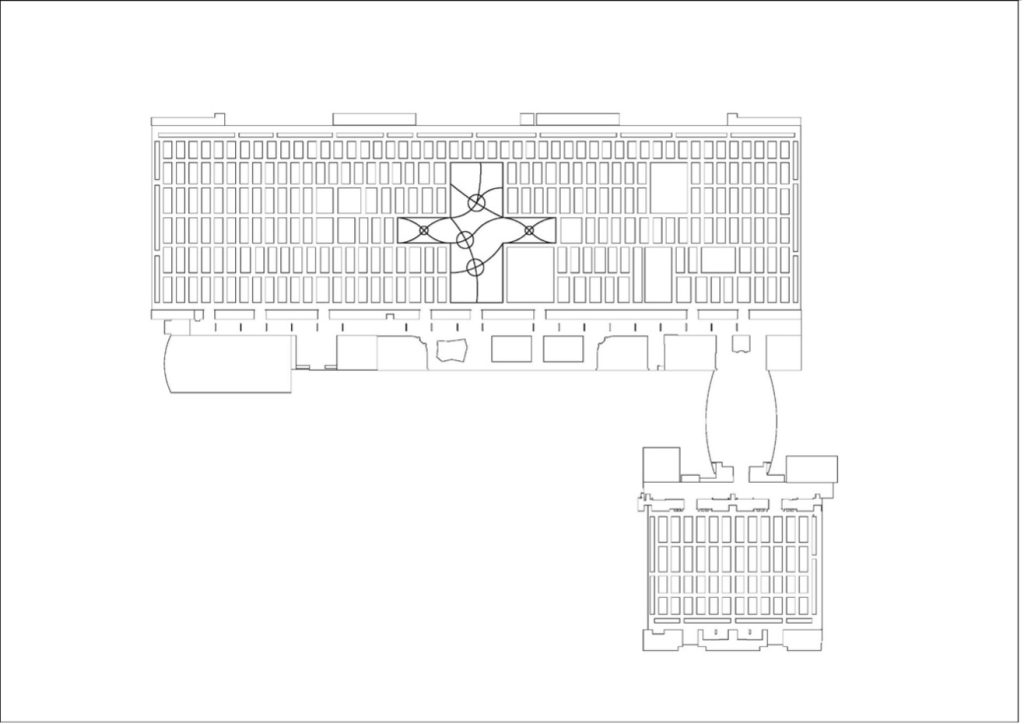
ผังพื้นส่วนกลางรูปกากบาทกับพาวิเลียนที่รายรอบ ปิยาเล่าให้ฟังถึงวิธีการจัดผังพื้นที่ส่วนจัดแสดงหลักของงานในปีนี้ที่เป็นพื้นที่ว่างรูปกากบาทบริเวณตรงกลาง รายล้อมด้วยบูธของผู้ร่วมแสดงงานในระบบกริดแบบตาราง
“เราใช้ Space Syntax ในการวิเคราะห์สภาพปัจจุบันของผังพื้นเดิมว่า ลักษณะการมองเห็นหรือเข้าถึงส่วนใดที่หนาแน่นหรือเบาบาง แล้วเราจึงแบ่งพื้นที่จัดแสดงงานออกเป็น 2 รูปแบบ คือพาวิเลียนแบบปิดล้อมและแบบเปิด กับ 16 ฟังก์ชั่นตามขนาดและรูปแบบการใช้งาน เช่น พาวิเลียนปิดที่สามารถมีกิจกรรมภายในพื้นที่ของตัวเองได้ สำหรับธีมพาวิเลียนหลัก พื้นที่สมาคมวิชาชีพ พื้นที่อาษาคลับ และพื้นที่จัดแสดงแบบเปิดที่สามารถเดินและมองทะลุผ่านได้ สำหรับพื้นที่โชว์เคส ผลงานเชิงทดลอง ผลงานของสมาชิกสมาคมและนักศึกษา พื้นที่ปรึกษาและเวทีหลัก”
จากการวิเคราะห์ข้อมูลทั้งหมดสวมเข้ากับแนวความคิด Activity Node จากผังจัตุรัสตรงกลางที่เป็นกากบาท จัดวางพาวิเลียนแบบปิดล้อมอยู่แนวนอนตามแกนกากบาท และพื้นที่จัดแสดงแบบเปิดในแนวตั้งรับกับทางเข้าหลัก
“พาวิเลียนแบบเปิดด้านหน้าจะช่วยดึงให้คนไหลเข้ามาแล้วค่อยกระจายตัวด้านใน ส่วนพาวิเลียนซ้ายและขวาซึ่งการจัดกลุ่มของสมาคมวิชาชีพไว้ด้วยกัน แล้วมีเวทีกลางเอาไว้จัดงานเสวนา ถือว่าเป็นไปตามทฤษฎีมาก เพราะเป็นกลุ่มของพาวิเลียนที่มีกิจกรรมสอดคล้องกันได้แชร์กันระหว่างวิชาชีพ แล้วสามารถรวมคนที่สนใจงานวิชาชีพมาอยู่ร่วมกันได้”

จากทฤษฎีและผังพื้นในแผ่นกระดาษสู่การจัดงานในวันจริง
ปิยาเล่าว่าความพิเศษของพาวิเลียนในปีนี้คือ ความสูงที่หลากหลาย ซึ่งช่วยขับให้เห็นสเปซและทางสัญจรที่ชัดเจนยิ่งขึ้น “เพราะง่ายที่สุดเลย เราอยากให้คนเข้าไปในสเปซแล้วไม่ควรหลง คือถ้าเราออกแบบสเปซแล้ว อยากให้คนรับรู้ทิศทางของตัวเองได้ เห็นว่าอยากเดินเข้าไปตรงไหน เราก็ถือว่าประสบความสำเร็จแล้ว”
ถ้าจะบอกว่าการจัดผังพื้นนิทรรศการเป็นหัวใจของงานสถาปนิก’67 เลยก็ไม่ผิดนัก และการนำเอาองค์ความรู้ด้านผังเมืองเข้ามามีส่วนในการออกแบบนับเป็นการสาธิต แนวความคิด ของวิชาชีพผ่านการปฏิบัติ จริงเพื่อให้ผู้คนได้รับรู้และเข้าใจผ่านภาษากลางร่วมกันคือ ภาษาสถาปัตยกรรม “เราคิดว่าทุกงาน ถ้าเรามองเห็นว่าทุกคนมีความเชี่ยวชาญหรือวิชาชีพเป็นของตัวเอง แล้วมีส่วนช่วยในการสร้างสรรค์ให้กับงานได้ เราว่าอันนี้เป็นสิ่งที่ทำให้มองเห็นถึงความพยายามในการใช้วิชาชีพของตัวเองอย่างเต็มประสิทธิภาพ การเคารพความเชี่ยวชาญของแต่ละคน และทำให้ภาพรวมของสังคมงานออกแบบในประเทศเราไปได้ไกล” พีรียาทิ้งท้ายถึงการถอดบทเรียนจากการทำงานในครั้งนี้
ส่วนปิยาเองได้มุมมองในการลงมือปฏิบัติงานในเรื่องความสมดุล “งานวางผังเป็นเหมือนงานกำหนดภาพรวม เราต้องบาลานซ์ระหว่างความ Fix และความ Flexible อย่างตอนแรกที่เริ่มมาเราก็คิดไปถึงขั้นว่าเราลงแบบไกด์รายละเอียดเลยไหมว่า ทางเดินต้องกว้าง 3 เมตร หรือพาวิเลียนต้องสูงไม่เกิน 5 หรือ 7 เมตร ซึ่งสุดท้ายแล้ว เราก็ต้องปรับให้เหลือแต่คีย์สำคัญ หรือมีบางอย่างที่ยืดหยุ่นได้ กระบวนการทำงานครั้งนี้จึงเป็นการเรียนรู้ที่สนุกดี ซึ่งมันก็เริ่มจากการที่เราเคารพในความเชี่ยวชาญของทุกฝ่ายที่จัดงาน”
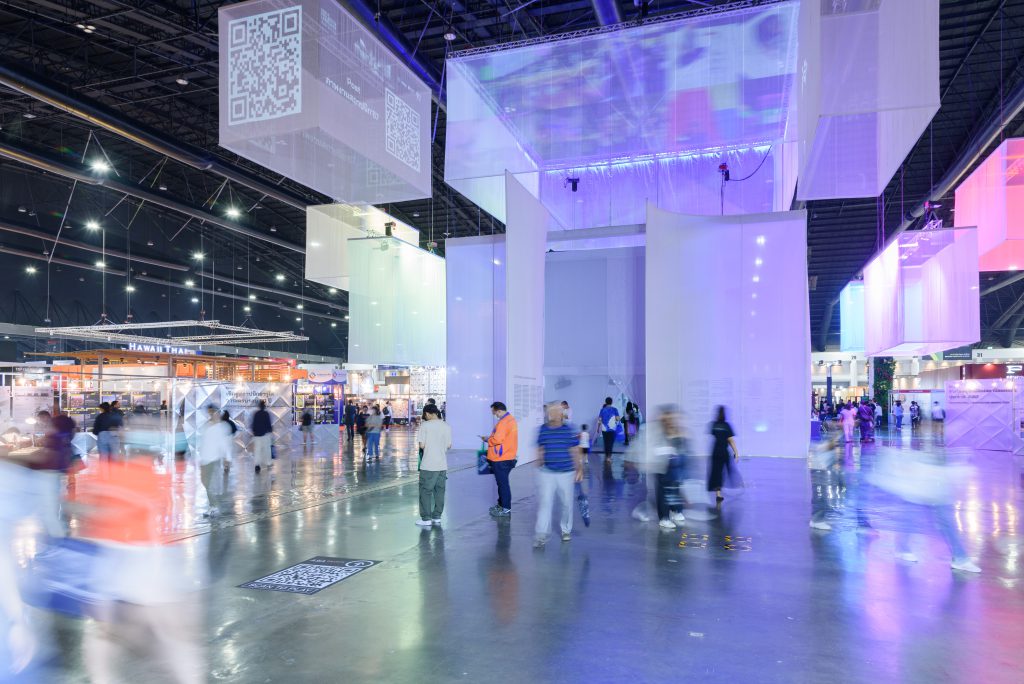
Collective (City) Language: Crafting Urban Miniatures Through the Lens of Pattern Language at Architect Expo’24
“We perceive the exhibition space as akin to a miniature city. The design, especially the central exhibition area, ought to be effortlessly navigable and not feel exclusive to any one individual. It should be a place where everyone feels comfortable to roam. This understanding is crucial,”
Dr. Pheereeya Boonchaiyapruek, Deputy Director of Urban Ally at the Faculty of Architecture, Silpakorn University, articulates. She introduces the conceptual framework for this year’s architectural exhibition layout, hosting over 500 exhibitors and crafting a microcosm of a city teeming with a medley of displays, activities, and products.
“It’s akin to a melting pot of diversity. In this condensed urban setting, we must forge a universal language that everyone can comprehend—a language that is architectural, inherently urban.” This idea aligns with the exhibition’s theme, “Collective Language.” Piya Limpiti, a Deputy Director at Urban Ally, elaborates further on the use of this urban vernacular to articulate and configure the exhibition’s spatial design.
Navigating the Architect Expo’24, especially the main exhibition area, presents a departure from prior iterations. The pathways are intentionally unstructured to facilitate free movement, enhancing the visibility of various activities and displays within the booths and ensuring each pavilion is distinctly visible. Here, the lexicon of urban design proves instrumental, shaping both the physical and perceptual dimensions of the space.

From Pattern Language to Activity Nodes
“In developing our exhibition floor plan, we sought a concept that would address the scale of a city designed for collective use. This pursuit led us to ‘A Pattern Language’ by Christopher Alexander, an urban architect and city theorist,” explains Pheereeya.
The book compiles characteristics of urban spaces that emerge from the arrangement of buildings, roadways, open spaces, and city activities into components of what constitutes a city. These concepts were incorporated and analyzed within the expo’s floor plan, along with using Space Syntax techniques. Space Syntax, an analytical tool for examining the relationships between various urban spaces through routes or movement between areas, was further developed into guidelines for designers in planning future layouts.
Urban Ally has adopted the language from ‘A Pattern Language’ to focus on creating ‘Activity Nodes.’ These nodes are characterized by four key features: main walking paths from the surrounding areas converging in a square, forming a star-shaped layout; small public squares; amenities that attract people; and distributed activity hubs.

“Public squares or communal areas designed for activities should have all walkways intersecting through their open spaces, creating a star-shaped layout at the convergence point. These squares do not need to be large and can be dispersed, with activity areas surrounding them. These activities should be interconnected to attract people with similar interests to the same area. The activity centers should be distributed throughout the space,” Pheereeya highlights.
She points out that using urban planning principles in designing the exhibition layout ensures the efficient use of the overall space, emphasizing the importance of communal public areas that belong to everyone. The allocation of space aligns with usage patterns, transforming previously underutilized or neglected areas into positive spaces that are fully functional.
“Ultimately, permeability and visibility are crucial factors for success. We are more likely to walk towards a destination if we can see it. Therefore, placing pavilions and creating focal points are essential in guiding the smooth flow of visitors through the different areas within the exhibition hall,” said Pheereeya.
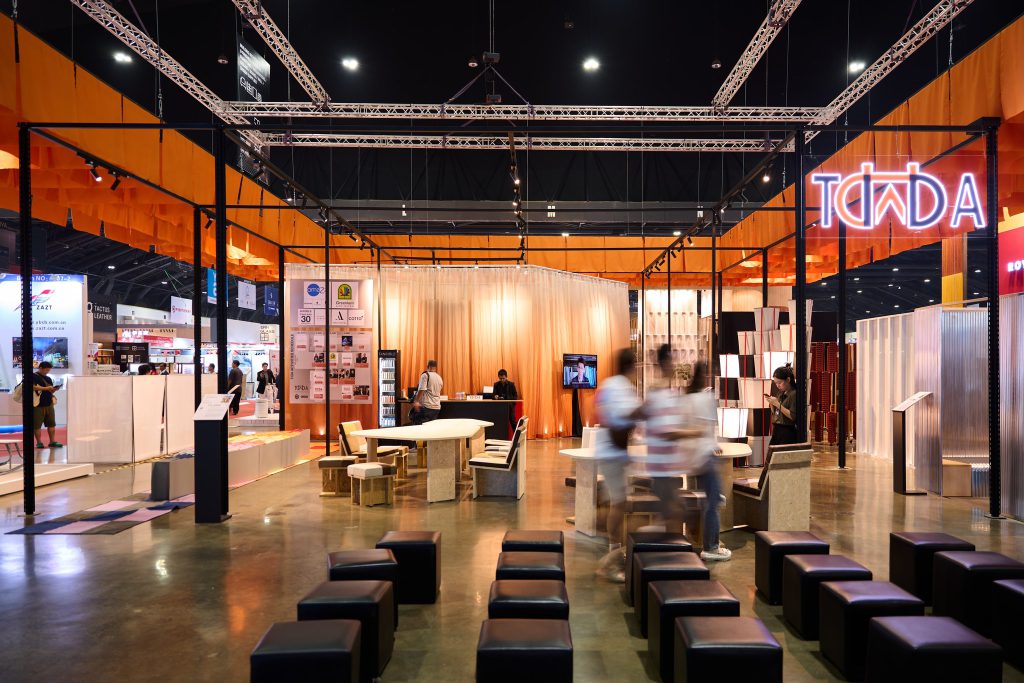
The Communal Space’s Cross-Shaped Layout and Surrounding Pavilions
Piya describes the design of this year’s main exhibition area, featuring a central cross-shaped open space surrounded by exhibitors’ booths arranged in a grid pattern. “We used Space Syntax to analyze the current layout, examining which areas had high or low visibility and accessibility. We then divided the exhibition space into two types: enclosed and open pavilions, with 16 functions based on size and usage. For example, enclosed pavilions can host activities within their space, such as the main thematic pavilions, the professional association spaces, the ASA Club area, and open display spaces for experimental showcases, member and student works, consultation areas, and the main stage.”
The entire layout analysis was integrated with the Activity Node concept, placing enclosed pavilions horizontally along the cross-axis and open display areas vertically to align with the main entrance. “The open pavilions at the front draw visitors in, who then disperse into other pavilions on the left and right. Grouping professional associations together with a central stage for seminars is consistent with the theory, as it clusters related activities and allows for interaction and knowledge sharing among professionals, attracting those interested in these fields to assemble,” Piya explains.
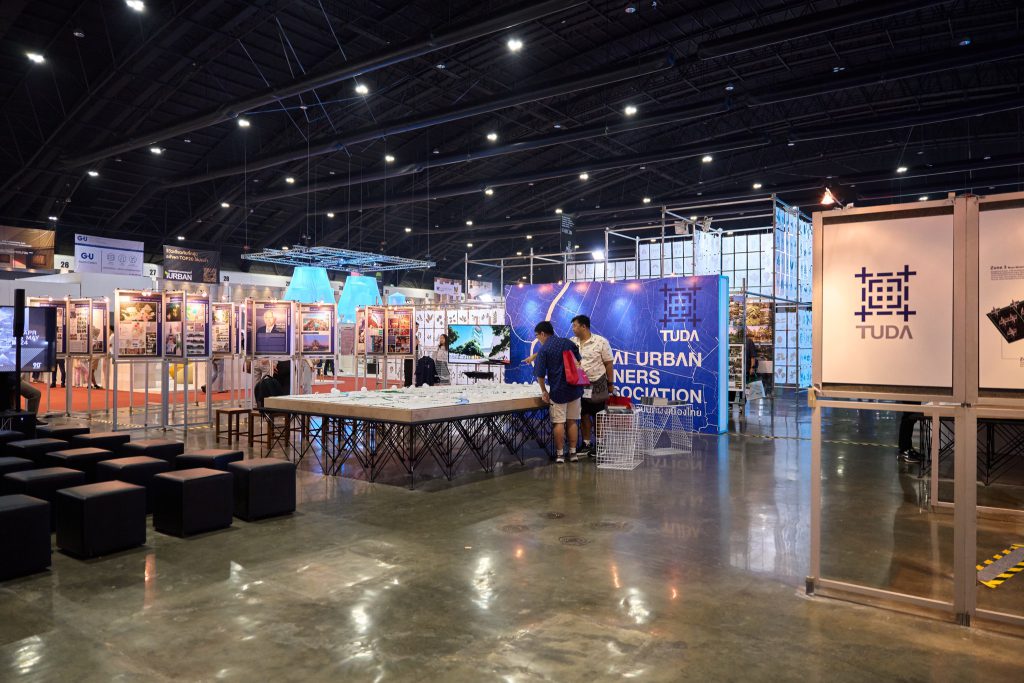
From Theories and Blueprints to Reality
Piya underscores a distinct feature of this year’s pavilions—their varied heights, which play a crucial role in enhancing the definition of spaces and pathways. “Our primary aim is straightforward: to prevent disorientation among visitors. Achieving this means our design is a success, as it aids in easy navigation and understanding of the space,” she explains.
Central to Architect’24 is its layout design, which serves as a live demonstration of urban planning principles. This hands-on experience enables attendees to grasp these concepts through architecture’s tactile and spatial language.
“We strongly believe that the success of any event hinges on recognizing and valuing the expertise of each participant. This philosophy not only maximizes professional skills but also honors individual knowledge, contributing significantly to advancing our country’s design community,” reflects Pheereeya, contemplating the insights gained from the endeavor.
Piya expands on the need for a careful balance in practical design work. “Effective layout planning involves sketching out the broad strokes. It’s a balanced fixed component with flexibility. Initially, we contemplated strict specifications, like pathways being three meters wide and pavilions capped at five to seven meters in height. Eventually, adjustments were necessary, focusing on key aspects while maintaining flexibility. This process has been an enjoyable learning experience, rooted in respecting the expertise of everyone involved in the event,” she concludes.
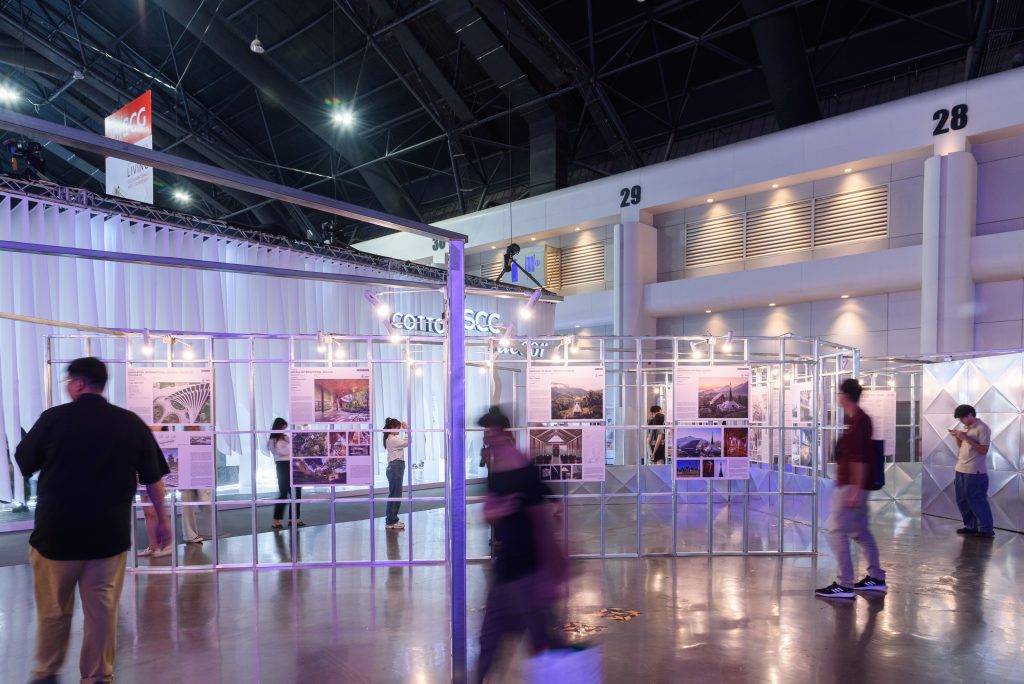
อ่านบทความคอลัมน์อื่นๆ หรือดาวน์โหลดเล่มวารสารฉบับออนไลน์ 18 Collective Language คลิกได้ที่นี่
อ่านบทความคอลัมน์อื่นๆ หรือดาวน์โหลดเล่มวารสารฉบับออนไลน์ Collective Language: EPILOGUE คลิกได้ที่นี่


